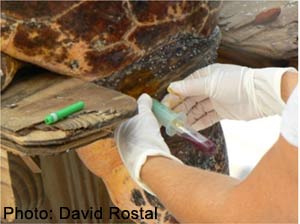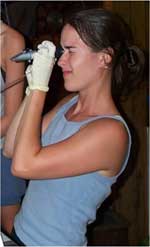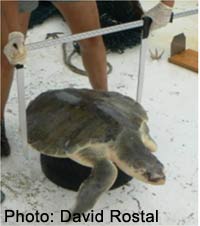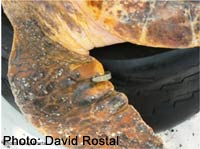Methods - Turtle processing procedures
Sea turtles are captured in ~70% of annual trawling events. Once brought on board, they are carefully removed from the net and examined for pre-existing tags.

Drawing blood from a juvenile loggerhead sea turtle aboard the RV Georgia Bulldog. Blood is collected from the dorsal cervical sinus (accessible from the topside of the neck) into a series of vacutainer tubes using a 21-gauge needle and hub apparatus. To facilitate pooling of blood in the sinus, turtles are oriented head-down in a specialized wooden platform for approximately one minute while blood is collected.
Following assignment of a unique identification number, blood samples (limited to 10% of total turtle blood volume [³]) are collected from the dorsal cervical sinus, which is located in the neck about two-thirds the distance between the head and the leading edge of the shell (carapace). To facilitate pooling of blood in this sinus, turtles are placed in a specialized restraint with their heads oriented downward. The needle insertion region is cleaned with Betadine and the needle and safety hub carefully inserted into the turtle’s neck, after which the tubes are inserted into the needle and begin filling with blood. Turtles are generally restrained in this position for less than one minute.
 A veterinary student from NC State University checks serum protein levels for a sea turtle aboard the FV Miss Tina in summer 2002. Serum protein levels are one of three diagnostic parameters measured for all sea turtles at sea during the health exam.
A veterinary student from NC State University checks serum protein levels for a sea turtle aboard the FV Miss Tina in summer 2002. Serum protein levels are one of three diagnostic parameters measured for all sea turtles at sea during the health exam.
Blood samples are processed immediately following collection. For most samples, the liquid (plasma) and cell components of the blood are separated using a centrifuge. For some collaborators, the tubes are frozen (-20C) after separation, but for others, only the plasma is saved. Plasma is removed via pipette and stored in cryovials that are frozen in liquid nitrogen (about -80C). A small amount of plasma is also placed on a specialized refractometer to determine blood protein levels. Hematocrit (i.e., red blood cell count) is determined by centrifuging a small amount of blood placed in a capillary tube, after which the cell count is read using a specialized chart. Blood glucose levels are determined using a standard diabetic meter.

Straight-line carapace width, one of 12 body size values recorded at sea, is measured for a juvenile Kemp’s ridley sea turtle aboard the RV Georgia Bulldog.
Concurrent with blood sample processing, morphometric measurements and a physical examination (to include photography) of body condition are conducted. During the physical examination, turtles are placed on top of foam-filled tires to restrict their mobility, which expedites the examination process and minimizes abrasion to the turtle shell and flippers. Turtles are also periodically cooled down with sea water during the exam. In addition to measurements, biological samples (epibionts, tissue) may also be collected for collaborators during the physical examination.

Close-up of a metal flipper tag in the front left flipper of a juvenile loggerhead sea turtle prior to release aboard the RV Georgia Bulldog.
Turtles are externally tagged with two Inconel flipper tags and subcutaneously tagged with a Passive Integrated Transponder (PIT) tag prior to release, which involves carefully lowering the turtle over the side of the vessel while it is out of gear. The basic turtle workup takes approximately 20 minutes to complete and release the turtle.
3 Jacobson E.R. 1998. Collecting and processing blood from sea turtles for hematologic and plasma biochemical determinations. In: Fair P., Hansen, L. (eds). Report of the Sea Turtle Health Assessment Workshop, 2-3 Feb 1998, part I: Background and Information Needs. NOAA Technical Memo NOS-NCCOS-CCEHBR-003, pp.24-28.
